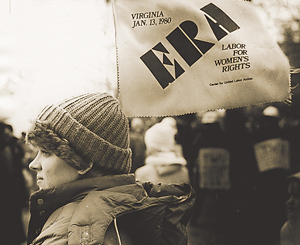Equality of rights under the law shall not be denied or abridged by the United States or by any state on account of sex. In 1923, Alice Paul (1885 -1977), suffragist, feminist, and one of the primary strategists for the campaign to ratify the Nineteenth Amendment to the U.S. Constitution which gave women the right to vote, introduced the Equal Rights Amendment to lawmakers in our nation’s capital.
 The amendment was presented in every session of Congress until it passed nearly fifty years later in 1972. But, in order to be added to the Constitution, the amendment – called the E.R.A. for short – needed ratification by thirty-eight state legislatures before a 1979 deadline. By 1977, only thirty-five states had approved it. Despite widespread protests at the Capitol in Richmond, Virginia was among the holdouts.
The amendment was presented in every session of Congress until it passed nearly fifty years later in 1972. But, in order to be added to the Constitution, the amendment – called the E.R.A. for short – needed ratification by thirty-eight state legislatures before a 1979 deadline. By 1977, only thirty-five states had approved it. Despite widespread protests at the Capitol in Richmond, Virginia was among the holdouts.
Gloria Steinem came to Richmond to rally supporters. In 1978, 3,000 activists marched to demand passage by the General Assembly. The national ratification deadline was then extended to 1982. For the next few years, demonstrators for both sides organized protests, counter-protests, and hearings in Richmond. Women’s rights advocates argued that the E.R.A. was needed to cement sex equality as a constitutional standard, not just as piecemeal acts passed by Congress. Acts could be revoked and did not create a reliable foundation for judicial precedent.
 Time and again, judges dismissed sex discrimination cases because that discrimination could not be proven to be unconstitutional. Opponents of the E.R.A. insisted that it was either redundant, unnecessary, represented federal overreach, or a “slippery slope into immorality.”
Time and again, judges dismissed sex discrimination cases because that discrimination could not be proven to be unconstitutional. Opponents of the E.R.A. insisted that it was either redundant, unnecessary, represented federal overreach, or a “slippery slope into immorality.”
In January 1980, more than 7,500 E.R.A. supporters marched in Richmond in one of the largest protests the Capitol Police had ever seen, but to no avail. Though the second deadline passed long ago, supporters of the E.R.A. continue to press for ratification, since the U.S. Constitution itself does not impose deadlines on the process. In 2017, Nevada approved the amendment. Some legal scholars argue that with two more states onboard, ratification may still be possible. Between 2011 and 2016, the Virginia Senate has passed resolutions ratifying the E.R.A. five times, but each time, the measure has died in the House of Delegates without a vote. Last month, the E.R.A. failed in the Virginia state legislature, with the House refusing to take up the matter, while a Senate panel defeated the measure by a vote of nine to five. The matter came before the General Assembly in 2019.
In 2020, Virginia became the pivotal 38th state to ratify the Equal Rights Amendment after its Senate and House of Delegates voted to approve the change to the U.S. Constitution.

Photos: Tim Wright, Gary Burns, Bob Brown, Richmond Times-Dispatch Collection
For more information on the status of the ERA in Virginia, visit VAratifyERA.org.





